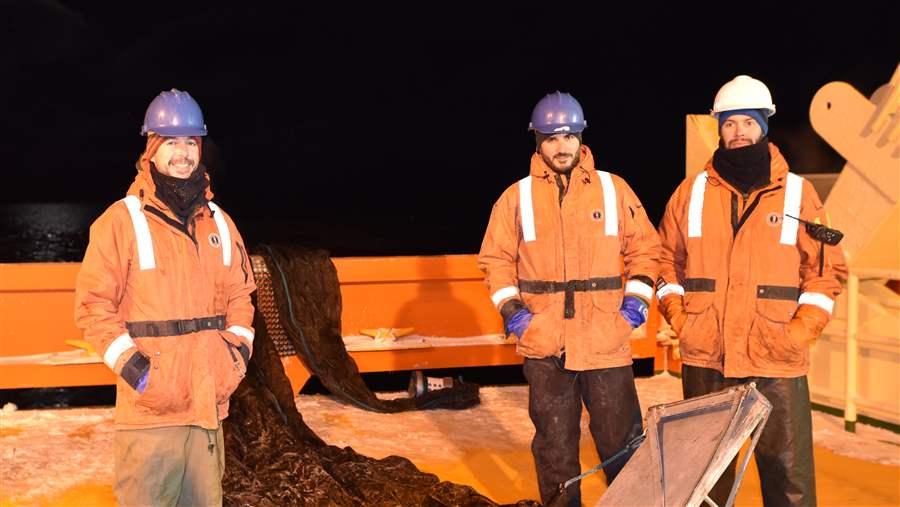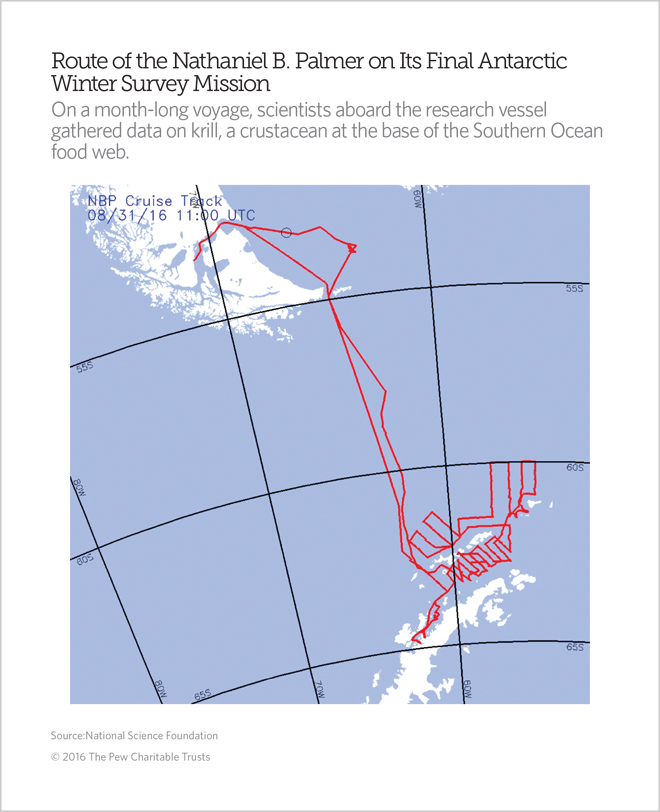The Daily Grind on Board the Nathaniel B. Palmer
A Month at the Bottom of the World
 © The Pew Charitable Trusts
© The Pew Charitable TrustsSean Mahaffey of Oregon State University, left, Ryan Dolan of Pew’s global penguin conservation campaign, and Tony Cossio of the National Oceanic and Atmospheric Administration begin their shift working for the Antarctic Marine Living Resources program on the Nathaniel B. Palmer.
This is the fourth in a series of dispatches by Ryan Dolan of The Pew Charitable Trusts’ global penguin conservation campaign, who has joined a team of Southern Ocean experts on a research expedition to the Antarctic—in the middle of winter.
While each day on board the Nathaniel B. Palmer holds surprises, the winter survey conducted by the Antarctic Marine Living Resources (AMLR) program is a finely tuned operation: Scientists follow a grid of predetermined sampling sites and transects to gather information about a changing ecosystem in the Antarctic. National Oceanic and Atmospheric Administration researchers have collected these data every year since 1990, resulting in 26 consecutive years of records. Since 2012, researchers have carried out this work during winter, further broadening scientists’ understanding of this remote and unique ecosystem and the creatures that live here.
As the vessel moves along transects between sampling stations, researchers use acoustic equipment to locate krill and measure their biomass in the waters below. AMLR program staff members will use those data to prepare biomass estimates for the entire region. During daylight, the ice tower crew peers through binoculars to observe above-water conditions and to catalog the presence of sea ice and predators such as whales, seals, penguins, and other seabirds.
Once we reach a sampling site, an instrument called a CTD, which measures ocean conductivity, temperature, and depth, is deployed to 750 meters below the surface. The CTD also measures other indicators at various depths, including fluorescence (presence of chlorophyll), pressure, and salinity. These indicators are important for understanding the overall productivity of a given sampling site at a given time.

Donning our extreme cold weather gear, steel-toed rain boots, and hard hats, the “zoo team” prepares the Isaacs-Kidd Midwater Trawl (IKMT)—a conical net used to collect zooplankton samples—for deployment. This is my favorite part of the process, as the sampling conditions from the back deck can be unpredictable and, in some cases, treacherous. We’ve encountered temperatures as low as minus 20 degrees Celsius with a wind chill of minus 47 degrees Celsius, winds upward of 40 knots, swells splashing onto the deck, and thick patches of sea ice that can cause hourslong delays and require some careful maneuvering by the captain. Despite continuously changing conditions, every part of collecting the sample takes place with practiced precision.
Once the IKMT is ready, the winch operator lowers the net from a crane overhead into the water, down to a depth of 170 meters. The captain has to hold the ship at a steady speed of around 2 knots or lower to maintain proper tension on the cable and to minimize damage to specimens caught in the net. Meanwhile, zoo team members in the aft control room monitor the operation to relay any safety hazards to the bridge and the back deck crew below. They also note readings from the various sensors that were deployed with the net to record abnormalities in the process that may influence the results.
Once the net reaches the desired depth, the winch operator slowly brings it back to the surface, where the deck crew hoses it off and removes the “codend”—a little bucket attached at the end of the net to collect zooplankton samples.
Afterward, the deck crew brings the codend inside to the Zoo Lab where, depending on the size of the sample, we distribute its contents into smaller basins that are kept cold with ice. That’s when we get our first glimpse of the various little critters we will work to identify, count, and archive. This expedition is collecting samples for a number of institutions, including NOAA, Germany’s Alfred Wegener Institute, the British Antarctic Survey, the University of Oregon, and Oregon State University.
You can see what critters we’re sorting and cataloging by following me at www.instagram.com/rt_dolan and twitter.com/rt_dolan and pewtrusts.org/penguins.
Ryan Dolan is an officer on The Pew Charitable Trusts' global penguin conservation campaign.







